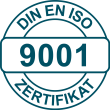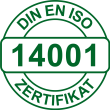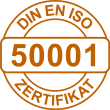Extraction device | FFF process | Application: air conditioning
Our manufacturing capabilities range from turned and milled parts, to turned-milled parts on state-of-the-art machining centers, to 3D printed components in a wide variety of manufacturing processes. In order to be able to offer our customers the highest quality, we are constantly expanding our know-how in order to optimize manufacturing methods and processes.
Our goal is to meet the increasing demands on tolerances, surface quality and repeatability and to exceed the requirements of our customers by permanently developing and modifying our machinery.
For this purpose, our engineers have developed a machine room cooling system so that production can be even more efficient while maintaining the same quality. An air circulation circuit ensures that the temperature of the machine rooms can be regulated and constantly maintained at the optimum machining temperature.

Our modified large-format printers enable the production of components up to one cubic meter in size. This gives the development department from Hänssler the freedom to specifically adapt the air channels for the circulation circuit to the respective machines.
The design of the very complex components is no problem thanks to 3D printing. This allows our systems to be produced in a space-saving manner, individually and also in unusual geometries. In this way, a consistent channel cross-section is achieved despite the non-uniform shape of the channel. The production of conventional air channels made of sheet metal is limited in cross-sections in the standard segment and can only be realized with great effort and expense for such an individual application. Various required geometries cannot be produced with this process in some cases or are subject to major compromises.
With the help of the measuring arm, a component from the large-capacity printer for the air conditioning of the machine park is measured
Two different 3D printing materials were used for the air channels, carbon fiber-reinforced PET (PET-CF) and recycled PET (rPET). PET-CF is characterized by its very good dimensional stability and high strength. It is used in areas where large forces act or components have to be cantilevered over a large area. Dimensional stability from our large-format printers is very good, and the optimized manufacturing process means that the components do not show any deformation. With a heat resistance of up to 100°C and its ESD capability, the material is ideally qualified for industrial applications. In addition, the material impresses with a very fine surface finish.

rPET, on the other hand, was used in areas where a certain elasticity of the components is required. During the production process of the CNC machine, vibrations happen where solid but brittle materials tend to crack and have to be additionally decoupled. Components made of rPET, on the other hand, can be assembled directly and withstand these conditions over a long period of time. As the name suggests, the material is made largely from recycled granules. Since sustainability plays a major role for us, rPET is used over other materials wherever conditions permit. Compared to PET-CF, this is significantly more economical and also conserves resources.
Here we present our available materials that are used in additive manufacturing. For each material, you will receive information on its properties and possible applications.

Large-format printers on this scale bring completely new possibilities. Components that previously could only be produced in partial segments on smaller printers can now be produced in one piece, without deformations and with the desired dimensional accuracy. In addition, fiber-reinforced materials can also be processed, which offer great potential in terms of strength and stiffness compared to the standard materials PET or PLA.
Hänssler Kunststoff- und
Dichtungstechnik GmbH
Edwin-Reis-Str. 5
68229 Mannheim, Germany
Phone: +49 (0) 621 48480-0
Fax: +49 (0) 621 48480-33


